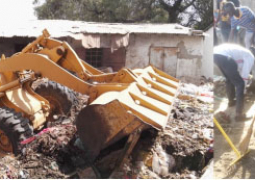Recently, Food Tank published a quick guide, “Rethinking Industrial Animal Production,” detailing the significant and far reaching consequences of a food system dominated by industrial animal production.
Industrial animal operations already account for the vast majority of animal production in the United States, and are responsible worldwide for 67 percent of poultry production, 50 percent of egg production, and 42 percent of pork production.
A rapidly growing industry - 80 percent of growth in the global livestock sector is from industrial animal operations or factory farms – its sheer size and intensity are key drivers behind a whole range of environmental problems.
In this new guide, we note this complexity, explaining the multifaceted and numerous consequences to factory farming.
Industrial animal production accounts for significant levels of global deforestation because land is cleared to grow feed crops—36 percent of global cereal crops are used to feed livestock, not people.
Factory farms—from feed to slaughter of animals—also require huge quantities of water. And, industrial animal operations contribute to a least 15 percent of greenhouse gas emissions worldwide.
But there are environmentally and socially responsible ways to produce meat, eggs, and dairy products. Limited antibiotic use, and stricter environmental and animal welfare standards are some of the alternatives highlighted in the guide.
More critically, the publication stresses the need for action from the donor community to support solutions.
Right now, industry has the deep pockets necessary to maintain the status quo, but groups working to create solutions and farmers wishing to change their methods lack the capital infrastructure necessary to move forward.
Animal production systems where livestock and workers are treated with dignity, farmers are fairly compensated, and waste is managed responsibly should be the future of animal production.
But making that transformation a reality will require additional research and funding and an increased level of engagement from everyone concerned about the food system.
The guide goes on to explain the additional risks posed to public health, our natural ecosystems, and our economy that urgently require a shift away from industrial animal production.
U.S. factory farms generate 40 times more waste than humans. This waste, in the form of runoff, contributes annually to a Connecticut-sized dead zone in the Gulf of Mexico.
That dead zone threatens the health of fish and other marine species, which threatens the health of the local fishing economy.
Additionally, the overuse and misuse of antibiotics has lead to super-bacteria that cause more than 20,000 deaths each year in the U.S. alone.
At the same time, local farmers struggle to survive when factory farms are in control. Driven out by a process called vertical integration, in Iowa today only 8,000 family farms raise their own livestock as compared to some 80,000 a quarter century ago.
Yet, as the guide highlights, there are concrete effective solutions to the hazards of factory farming. Ultimately, what’s needed is greater investment in alternative forms of livestock production that protect animal welfare, the environment, worker safety, and public health.
Read Other Articles In Article (Archive)
Gambia Methodist Tops GABECE Exams
Sep 24, 2009, 5:31 AM

Global Hands engages young entrepreneurs to inspire students
Oct 27, 2015, 10:36 AM


